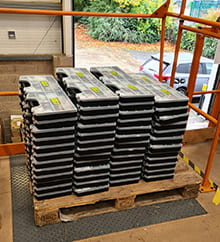Engineering at home kits: Bringing the lab to our students
Hands on experimentation, collaboration and practical sessions are key to our student’s learning experiences. So, this year has been a particular challenge for our teaching staff. Social distancing guidelines have more than halved our lab capacity and the possibility of lockdowns and travel restrictions meant staff needed to completely rethink the way they taught this year.
Teaching staff had to figure out how to deliver the best possible education, meet learning objectives and ensure that students had equality of access to facilities no matter where they were. Our academics put their heads together, consulted with the Institute of Mechanical Engineering and the Institution of Engineering and Technology (IET), and took advice from our technical services staff, and the Bristol ‘at home lab kit’ was born.
Sending 1000s of lab kits around the world
 At home kits aren’t new within our faculty; Electronic and Electrical Engineering students have been able to borrow ‘a lab in a briefcase’ kit for several years. However, the challenges of scale, safety and international shipping meant that these kits were a whole new proposition.
At home kits aren’t new within our faculty; Electronic and Electrical Engineering students have been able to borrow ‘a lab in a briefcase’ kit for several years. However, the challenges of scale, safety and international shipping meant that these kits were a whole new proposition.
We’ve sent out 5 different types of at home kit to more than 1250 Bristol students on a variety of our programmes. Students have received kits around the world, with destinations including Romania, Brunei, Zimbabwe, Brazil, and Mauritius!
The ‘big’ kit
 The biggest kit, both in terms of components and number of recipients, was sent to all first year Aerospace, Civil, Mechanical and Engineering Design students. Creating something which would support aerospace, mechanical, and civil engineering principles has been an exciting project, but it’s also in-line with the increasingly interdisciplinary nature of engineering.
The biggest kit, both in terms of components and number of recipients, was sent to all first year Aerospace, Civil, Mechanical and Engineering Design students. Creating something which would support aerospace, mechanical, and civil engineering principles has been an exciting project, but it’s also in-line with the increasingly interdisciplinary nature of engineering.
The specifications for the kit were exacting, with multiple non-standard components and over 200 components in total.
High-tech and low-fi components
The kit contents had to be safe (both in terms of what can be done at home and what can be legally posted around the world) with a mix of hi-tech and low-fi components to get students thinking in the physical rather than the theoretical realm. We wanted to encourage everyone to get ‘hands on’ with a mix of simple experiments which will be conducted in real time and longer-term projects to be done outside of formal teaching sessions. We hope, and encourage, that students will make time to play and experiment on their own. Some examples of items included in the “big” kits are:
Study at Bristol
Aerospace Engineering
Civil Engineering
Mechanical Engineering
- Engineering drawing tools/pencils
- Measurement tools like calipers, steel rule, and measuring cylinders
- Balls of string, copper wire, masking tape
- Electronics equipment: prototyping board, microcontroller, servo motor, various components, wire cutters
- A strain gauge set-up
- Lego for the mechanical engineers!
The best bit is that these kits were designed to last for the duration of a student’s degree programme and beyond. And it’s possible that some components students will keep forever!
Examples of experiments with at home kits
 Bristol at home kits are used for a range of activities, but some examples are:
Bristol at home kits are used for a range of activities, but some examples are:
- Calculating the moment of inertia using simple household items such as a in a tin can or a toilet roll
- Programming a robot
- Prototyping electronics (using a microcontroller/servo motor etc)
- Simple bending – measuring deflection of a beam and comparing to theory
- Measuring strain – an extension of the simple bending lab but using strain gauges developed from kit components
What’s next?
Although we might be back to normal next September, we’ve seen great advantages to students having these kits and running their own experiments at home this year. Students have to be independent and get more opportunity to be creative engineers with access to their own equipment. So we’re looking into the possibility of continuing something similar for future years and build on the success of what has been a dynamic and energising year for practical teaching.


